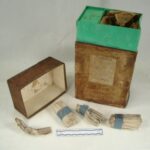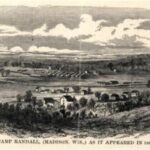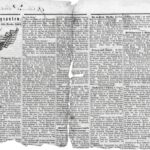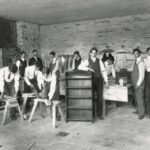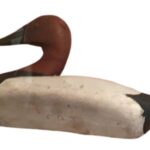University of Wisconsin-Madison’s Camp Randall Stadium has been through many transformations yet has remained a pillar of statewide community. First put to public use as fairground enjoyed by residents across the state of Wisconsin, the site housed the state’s largest soldier training facility for the Union Army during the Civil War (briefly also housing a Confederate soldier prison) and was eventually purchased by the University to be used as an athletic field. Camp Randall Stadium has seen hundreds of Badger victories, cheered on by Wisconsinites from around the state. Throughout the site’s evolution, the area remains a place of community and a source of pride for state residents.
Prior to the Civil War, and before earning the name Camp Randall, locals knew the area as the William D. Bruen Estate. In the late 1850s, the State Agricultural Society leased the grounds for their organization’s use, including hosting the Wisconsin State Fair—which they did ten times between 1858 and 1885 before the Fair found its permanent home at West Allis in 1892. Wisconsinites from far and wide flocked to the state capital to amuse themselves. Catering to the shared interests of Wisconsin farmers, the State Fair centered around agricultural progress, and visitors marveled at the large farm machinery set on display from Wisconsin farms, showcasing the power of the state’s growing agriculture industry. The 1860 State Fair, for instance, exhibited inventions by John Muir, a native Wisconsinite, including an automatic horse feeder. Usually lasting four to five days in early autumn, the event brought together state residents in celebration of Wisconsin achievements and shared identity thus fostering a sense of state pride and unity.
Following an attack at Fort Sumter in April 1861, President Abraham Lincoln decreed that each northern state must provide troops for the Union Army. Wisconsin Governor Alexander Randall quickly began to muster volunteer soldiers. Due to the war, the Wisconsin State Fair did not take place that year, but instead the State Agricultural Society provided the fairground for mustering purposes, as the flat open land was well-suited for drilling soldiers. The state remodeled buildings that remained from the 1860 State Fair for use by the Second Wisconsin Regiment. The site’s name Camp Randall was chosen and remains today in commemoration of the state’s first war-time Governor. Incredibly, of the 92,000 Wisconsin soldiers in the Union Army, 70,000 trained for battle in Madison.
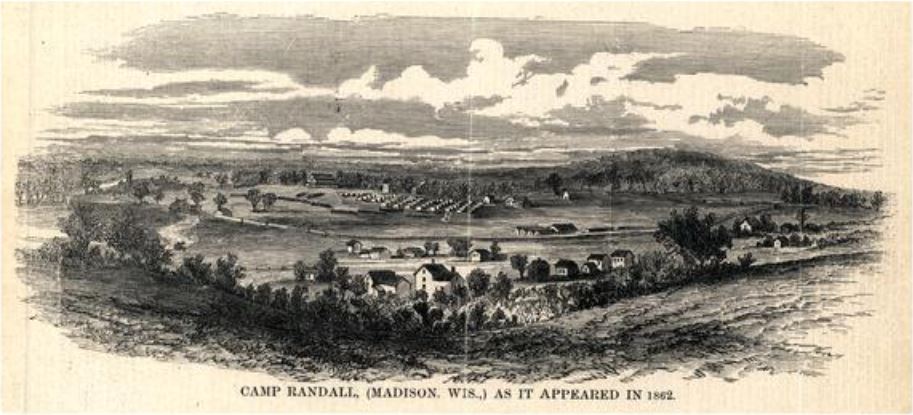
Troops at Camp Randall lived in harsh conditions. Wisconsin support of the United States Army was profound, and the training site welcomed many volunteer soldiers from around the state. But the heavy turnout overwhelmed the camp, and those who did not secure a spot in the barracks crammed into tents. Measles, typhoid fever, and other diseases spread like wildfire through the regiments during the first winter in Madison. Sanitation and increasing soldier medical care standards were new concepts during this time period. Hospital renovations and building expansions were made in effort to improve substandard living conditions and to accommodate an influx of new soldiers. During training, strong leadership resulted in exceptional soldiers. Many men in the Union Army’s famous Iron Brigade started at Camp Randall. While the location’s primary purpose was to train Wisconsin soldiers, it was also temporarily used as a Confederate prisoner of war camp beginning in April of 1862. Though a significant period of its history, the prisoner of war camp was short lived. At the end of May, the Union ordered the prisoners to Camp Douglas, a larger facility in Chicago, and Camp Randall returned solely to a soldier training camp.
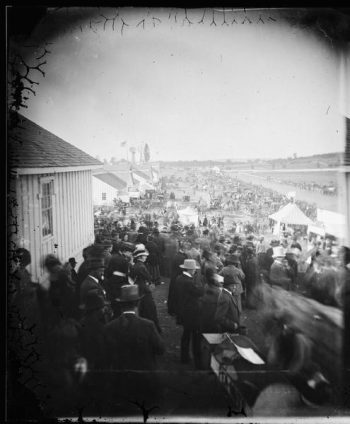
In 1865, following the end of the Civil War, the state returned the site of Camp Randall to the Wisconsin State Agricultural Society for its continued use as fairground. During this period, due to urban expansion, developers became interested in the land’s prime location. However, public outrage and a growing interest in preserving the site’s history stalled the decision to sell the renowned site. The Grand Army of the Republic’s Wisconsin department, an organization of Civil War veterans, released a statement in support for Camp Randall’s preservation; an excerpt from their compelling statement depicts grounds’ historical significance:
“The ground upon which the campfires were first built in this state in the war of the union, where the knowledge of war and its hardships were first taught, where the ties of comradeship that will hold until the end were first formed, should be purchased by the state and beautified and forever held as a memorial park.”
The Wisconsin state legislature bought the Camp Randall grounds in 1893 and deeded the property to the University of Wisconsin-Madison. The flat area where Wisconsin Union soldiers held drill practices proved to be a fine location for the University’s athletic field. The University’s track and field team became the first to use the location for Badger athletics, followed closely behind by the Badger football team beginning in 1895. The site once again became alive with activity, but those who came before were never forgotten.
The state built the iconic Memorial Arch in 1911, dedicating it to the 70,000 Civil War veterans trained at Camp Randall. The Arch features two statues, one a young soldier off to battle and the other a veteran returning many years later. The University of Wisconsin-Madison built Camp Randall Stadium in 1917 to accommodate the growing turnout of fans traveling from around the state to cheer on the Wisconsin Badgers. Following expansions throughout the 20th century, Camp Randall Stadium today stands as a massive icon of the University of Wisconsin-Madison, holding a record attendance of 83,069 fans. Along with football games, the Wisconsin community has come together to witness countless concerts, observances, and graduations on these grounds.
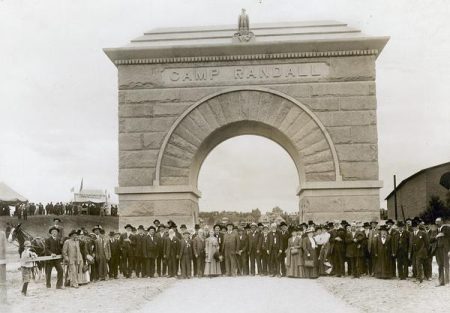
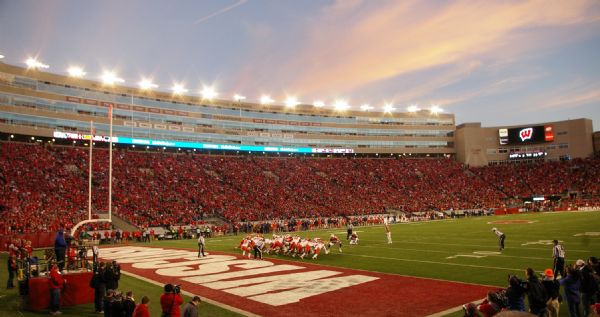
Throughout its history, Camp Randall has proved to be a place of community and Wisconsin identity. In the nineteenth century, the Wisconsin State Fair brought the state together to celebrate their agricultural achievements. The site’s transformation to Camp Randall and the massive influx of volunteer soldiers depicted the strength of the state and its unified commitment to the Union. Since its completion, Camp Randall Stadium has hosted many victories and celebrations on the University of Wisconsin-Madison campus bringing together Wisconsinites from all around to cheer on their beloved Badgers. From fair gatherings of citizens statewide, exceptional Wisconsin soldiers, and electric Badger football game days, Camp Randall’s legend as Madison’s pride and a place of Wisconsin community continues on.
Written by Chloe Bonchonsky, September 2023.
Sources
“Camp Randall Stadium.” University of Wisconsin-Madison. Accessed December 1, 2022. https://uwbadgers.com/sports/2015/8/21/GEN_2014010132.aspx
Chauncey H. Cooke. “Letters of a Badger Boy in Blue: Life at Old Camp Randall.” The Wisconsin Magazine of History 4, no. 2 (1920): 208–17. http://www.jstor.org/stable/4630298.
“History of the Camp Randall Arch.” University of Wisconsin-Madison. Accessed December 1, 2022. https://uwbadgers.com/sports/2015/08/21/GEN_20140101557.aspx
“History of Wisconsin State Fair.” Wisconsin State Fair. Accessed December 1, 2022. https://wistatefair.com/fair/history/
Carolyn J. Mattern, Soldiers When They Go: The Story of Camp Randall, 1861-1865. Madison: State Historical Society of Wisconsin, 1981.
Tommy Thompson, “‘Dying like Rotten Sheepe’: Camp Randall as a Prisoner of War Facility during the Civil War.” The Wisconsin Magazine of History 92, no. 1 (2008): 2–15. http://www.jstor.org/stable/25482093.
John Zimm, “‘ON, WISCONSIN!’: Celebrating Camp Randall.” The Wisconsin Magazine of History 102, no. 1 (2018): 28–37. https://www.jstor.org/stable/26541154.
